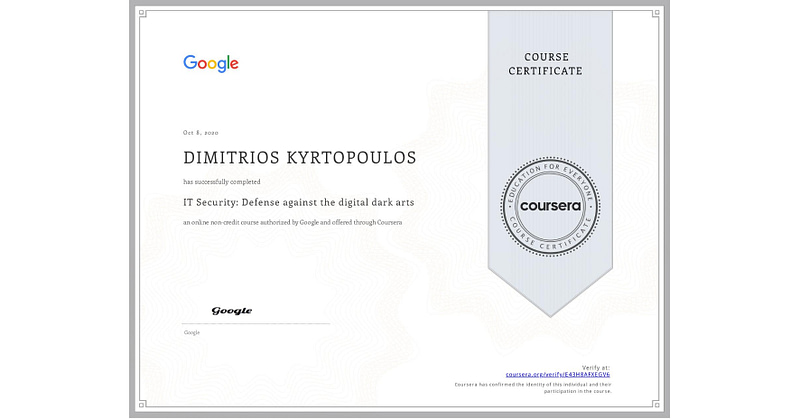Google IT Security: Defense against the digital dark arts
Instructors
About this Course
This course covers a wide variety of IT security concepts, tools, and best practices. It introduces threats and attacks and the many ways they can show up. We’ll give you some background of encryption algorithms and how they’re used to safeguard data. Then, we’ll dive into the three As of information security: authentication, authorization, and accounting. We’ll also cover network security solutions, ranging from firewalls to Wifi encryption options. The course is rounded out by putting all these elements together into a multi-layered, in-depth security architecture, followed by recommendations on how to integrate a culture of security into your organization or team.
At the end of this course, you’ll understand:
● how various encryption algorithms and techniques work as well as their benefits and limitations.
● various authentication systems and types.
● the difference between authentication and authorization.
● how to evaluate potential risks and recommend ways to reduce risk.
● best practices for securing a network.
● how to help others to grasp security concepts and protect themselves.
Skills you will gain
Cybersecurity
Wireless Security
Cryptography
Network Security
Syllabus
Week 1: Understanding Security Threats
Welcome to the IT Security course of the IT Support Professional Certificate! In the first week of this course, we will cover the basics of security in an IT environment. We will learn how to define and recognize security risks, vulnerabilities and threats. We’ll identify the most common security attacks in an organization and understand how security revolves around the “CIA” principle. By the end of this module, you will know the types of malicious software, network attacks, client-side attacks, and the essential security terms you’ll see in the workplace.
Week 2: Pelcgbybtl (Cryptology)
In the second week of this course, we’ll learn about cryptology. We’ll explore different types of encryption practices and how they work. We’ll show you the most common algorithms used in cryptography and how they’ve evolved over time. By the end of this module, you’ll understand how symmetric encryption, asymmetric encryption, and hashing work; you’ll also know how to choose the most appropriate cryptographic method for a scenario you may see in the workplace.
Week 3: AAA Security (Not Roadside Assistance)
In the third week of this course, we’ll learn about the “three A’s” in cybersecurity. No matter what type of tech role you’re in, it’s important to understand how authentication, authorization, and accounting work within an organization. By the end of this module, you’ll be able to choose the most appropriate method of authentication, authorization, and level of access granted for users in an organization.
Week 4: Securing Your Networks
In the fourth week of this course, we’ll learn about secure network architecture. It’s important to know how to implement security measures on a network environment, so we’ll show you some of the best practices to protect an organization’s network. We’ll learn about some of the risks of wireless networks and how to mitigate them. We’ll also cover ways to monitor network traffic and read packet captures. By the end of this module, you’ll understand how VPNs, proxies and reverse proxies work; why 802.1X is a super important for network protection; understand why WPA/WPA2 is better than WEP; and know how to use tcpdump to capture and analyze packets on a network. That’s a lot of information, but well worth it for an IT Support Specialist to understand!
Week 5: Defense in Depth
In the fifth week of this course, we’re going to go more in-depth into security defense. We’ll cover ways to implement methods for system hardening, application hardening, and determine the policies for OS security. By the end of this module, you’ll know why it’s important to disable unnecessary components of a system, learn about host-based firewalls, setup anti-malware protection, implement disk encryption, and configure software patch management and application policies.
Week 6: Creating a Company Culture for Security
Congratulations, you’ve made it to the final week in the course! In the last week of this course, we’ll explore ways to create a company culture for security. It’s important for any tech role to determine appropriate measures to meet the three goals of security. By the end of this module, you will develop a security plan for an organization to demonstrate the skills you’ve learned in this course. You’re almost done, keep up the great work!

